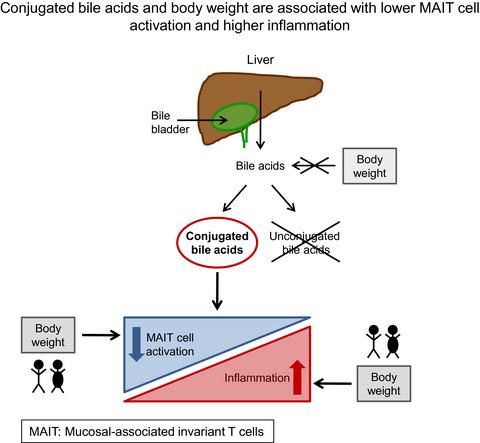当前位置:
X-MOL 学术
›
Clin. Exp. Immunol.
›
论文详情
Our official English website, www.x-mol.net, welcomes your
feedback! (Note: you will need to create a separate account there.)
MAIT cell activation in adolescents is impacted by bile acid concentrations and body weight.
Clinical & Experimental Immunology ( IF 3.4 ) Pub Date : 2020-02-17 , DOI: 10.1111/cei.13423 A Mendler 1 , A Pierzchalski 1 , M Bauer 1 , S Röder 1 , A Sattler 2 , M Standl 3 , M Borte 4 , M von Bergen 5, 6 , U Rolle-Kampczyk 5 , G Herberth 1
Clinical & Experimental Immunology ( IF 3.4 ) Pub Date : 2020-02-17 , DOI: 10.1111/cei.13423 A Mendler 1 , A Pierzchalski 1 , M Bauer 1 , S Röder 1 , A Sattler 2 , M Standl 3 , M Borte 4 , M von Bergen 5, 6 , U Rolle-Kampczyk 5 , G Herberth 1
Affiliation

|
Bile acids (BAs) are produced by liver hepatocytes and were recently shown to exert functions additional to their well-known role in lipid digestion. As yet it is not known whether the mucosal-associated invariant T (MAIT) cells, which represent 10-15% of the hepatic T cell population, are affected by BAs. The focus of the present investigation was on the association of BA serum concentration with MAIT cell function and inflammatory parameters as well as on the relationship of these parameters to body weight. Blood samples from 41 normal weight and 41 overweight children of the Lifestyle Immune System Allergy (LISA) study were analyzed with respect to MAIT cell surface and activation markers [CD107a, CD137, CD69, interferon (IFN)-γ, tumor necrosis factor (TNF)-α] after Escherichia coli stimulation, mRNA expression of promyelocytic leukemia zinc finger protein (PLZF) and major histocompatibility complex class I-related gene protein (MR1), the inflammatory markers C-reactive protein (CRP), interleukin (IL)-8 and macrophage inflammatory protein (MIP)-1α as well as the concentrations of 13 conjugated and unconjugated BAs. Higher body weight was associated with reduced MAIT cell activation and expression of natural killer cell marker (NKp80) and chemokine receptor (CXCR3). BA concentrations were positively associated with the inflammatory parameters CRP, IL-8 and MIP-1α, but were negatively associated with the number of activated MAIT cells and the MAIT cell transcription factor PLZF. These relationships were exclusively found with conjugated BAs. BA-mediated inhibition of MAIT cell activation was confirmed in vitro. Thus, conjugated BAs have the capacity to modulate the balance between pro- and anti-inflammatory immune responses.
中文翻译:

青少年的 MAIT 细胞激活受到胆汁酸浓度和体重的影响。
胆汁酸 (BA) 由肝细胞产生,最近被证明除了众所周知的脂质消化作用外,还发挥其他功能。目前尚不清楚占肝 T 细胞群 10-15% 的粘膜相关不变 T (MAIT) 细胞是否受到 BA 的影响。本研究的重点是 BA 血清浓度与 MAIT 细胞功能和炎症参数的关系以及这些参数与体重的关系。对生活方式免疫系统过敏 (LISA) 研究中 41 名正常体重和 41 名超重儿童的血液样本进行了 MAIT 细胞表面和激活标记物 [CD107a、CD137、CD69、干扰素 (IFN)-γ、肿瘤坏死因子 (TNF) )-α]大肠杆菌刺激后,早幼粒细胞白血病锌指蛋白(PLZF)和主要组织相容性复合体I类相关基因蛋白(MR1)、炎症标志物C反应蛋白(CRP)、白细胞介素(IL)的mRNA表达量- 8 和巨噬细胞炎症蛋白 (MIP)-1α 以及 13 种缀合和未缀合 BA 的浓度。体重增加与 MAIT 细胞活化以及自然杀伤细胞标记物 (NKp80) 和趋化因子受体 (CXCR3) 表达的减少有关。 BA 浓度与炎症参数 CRP、IL-8 和 MIP-1α 呈正相关,但与激活的 MAIT 细胞和 MAIT 细胞转录因子 PLZF 的数量呈负相关。这些关系仅在共轭 BA 中发现。 BA 介导的 MAIT 细胞活化抑制作用在体外得到证实。因此,结合的 BA 能够调节促炎和抗炎免疫反应之间的平衡。
更新日期:2020-02-17
中文翻译:

青少年的 MAIT 细胞激活受到胆汁酸浓度和体重的影响。
胆汁酸 (BA) 由肝细胞产生,最近被证明除了众所周知的脂质消化作用外,还发挥其他功能。目前尚不清楚占肝 T 细胞群 10-15% 的粘膜相关不变 T (MAIT) 细胞是否受到 BA 的影响。本研究的重点是 BA 血清浓度与 MAIT 细胞功能和炎症参数的关系以及这些参数与体重的关系。对生活方式免疫系统过敏 (LISA) 研究中 41 名正常体重和 41 名超重儿童的血液样本进行了 MAIT 细胞表面和激活标记物 [CD107a、CD137、CD69、干扰素 (IFN)-γ、肿瘤坏死因子 (TNF) )-α]大肠杆菌刺激后,早幼粒细胞白血病锌指蛋白(PLZF)和主要组织相容性复合体I类相关基因蛋白(MR1)、炎症标志物C反应蛋白(CRP)、白细胞介素(IL)的mRNA表达量- 8 和巨噬细胞炎症蛋白 (MIP)-1α 以及 13 种缀合和未缀合 BA 的浓度。体重增加与 MAIT 细胞活化以及自然杀伤细胞标记物 (NKp80) 和趋化因子受体 (CXCR3) 表达的减少有关。 BA 浓度与炎症参数 CRP、IL-8 和 MIP-1α 呈正相关,但与激活的 MAIT 细胞和 MAIT 细胞转录因子 PLZF 的数量呈负相关。这些关系仅在共轭 BA 中发现。 BA 介导的 MAIT 细胞活化抑制作用在体外得到证实。因此,结合的 BA 能够调节促炎和抗炎免疫反应之间的平衡。











































 京公网安备 11010802027423号
京公网安备 11010802027423号